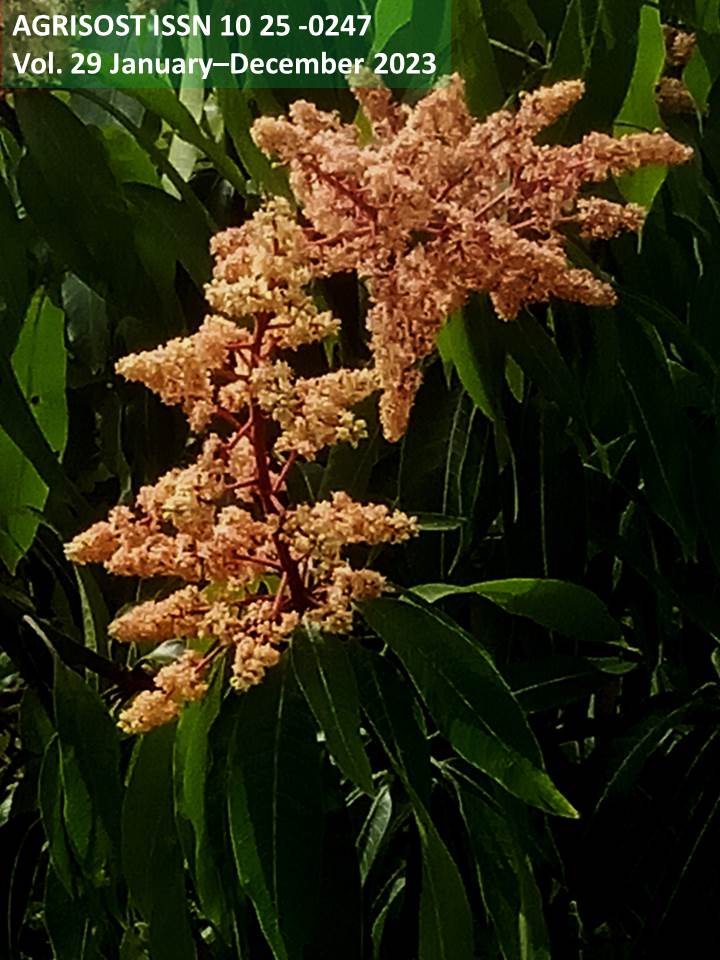Tolerance of rhizobia from chickpea nodules (Cicer arietinum L.) against abiotic factors
DOI:
https://doi.org/10.5281/zenodo.8321988Keywords:
factors abiotic, rhizobia, toleranceAbstract
Context: The stress abiotic alters the physiologic and metabolic processes of the plants, for what is considered the central cause of the losses of the cultivations, of there the necessity to study the effect of microorganisms that you/they contribute to counteract these effects.
Objective: To select for their tolerance in front of factors isolated abiotic of rhizobia coming from nodules of the cultivation of the chickpea (Cicer arietinum L.) to contribute to the adaptability of the cultivation before the same ones.
Methods: The tolerance was studied in front of isolated factors abiotic of eleven of rhizobia from chickpea nodules (Cicer arietinum L.). it was characterized under conditions in vitro its tolerance in front of different pH levels, chloride of sodium (NaCl), temperatures and drought.
Results: Eleven rhizobias was studied by its capacity to tolerate different pH levels, all grew in a range from 6 to 8. Of them, 4 isolated 8,5 grew to pH and to pH 9 were only able to grow two of them. To concentrations of NaCl, all grew to concentrations between 0,5 and 0,6%, starting from 0,7% NaCl, 7 of the isolated, alone only grew two of them they grew to concentrations between 1 and 1,5% NaCl and none tolerated 2% of NaCl. With respect to the tolerance to the different ranges of temperature, all grew to 35 oC, of them 63% grew to 36 oC and only two isolated they grew to 37 oC. Alone an isolated one tolerated between 38 and 39 oC and to 40 oC none showed growth. The tolerance a conditions of drought, only two isolated grew in presence de 3% PEG 6000.
Conclusions: Coming from nodules of the cultivation of the chickpea (Cicer arietinum L.) some rizobios was evaluated with tolerance in front of different pH levels, chloride of sodium (NaCl), temperatures and drought, what will allow contributing to the adaptability of the cultivation before these effects under the conditions of Cuba.
Downloads
References
Andrews, M., & Andrews, M. E. (2017). Specificity in Legume-Rhizobia Symbioses. International Journal of Molecular Sciences, 18(4),705. http://dx.doi.org/10.3390/ijms18040705
Al-Saedi, S. A., Razaq, I. B., & Ali, N. A. (2016). Utilization of 15N dilution analysis for measuring efficiency of biological nitrogen fixation under soil salinity stress. Journal of Pharmacy and Pharmaceutical Sciences, 5(1), 1468-1479.
Apáez, M., Escalante, J. A. S.., Apáez, P., & Álvarez, J. C. (2020). Producción, crecimiento y calidad nutrimental del garbanzo en función del nitrógeno y fósforo. Revista Mexicana Ciencias Agrícolas, 11(6), 1273-1284. http://dx.doi.org/10.29312/remexca.v11i6.2226
Cruz Barrera, M., Jakobs-Schoenwandt, D., Gómez, M. I., Becker, M., Patel, A. V., & Ruppel, S. (2019). Salt stress and hydroxyectoine enhance phosphate solubilisation and plant colonization capacity of Kosakonia radicincitans. Journal of Advanced Research, 19, 91-97. https://doi.org/10.1016/j.jare.2019.03.012
Basu, A., Prasad, P., Das, S.N., Kalam, S., Sayyed, R.Z., Reddy, M.S., & El Enshasy, H. (2021). Plant growth promoting rhizobacteria (PGPR) as green bioinoculants: Recent developments, constraints, and prospects. Sustainability, 13 (3), 1140. https://doi.org/10.3390/su13031140
Bécquer Granados, C. J. (2022). Las rizobacterias y su contribución a la tolerancia de las plantas a la sequía y a la salinidad. Cuban Journal of Agricultural Science, 56(2), e06. http://scielo.sld.cu/scielo.php?script=sci_arttext&pid=S2079-34802022000200006&lng=es&tlng=es
Bécquer, C. J., Galdo, Y., Mirabal, A., Quintana, M., & Puentes, A. (2017). Rizobios aislados de leguminosas forrajeras de un ecosistema ganadero árido de Holguín, Cuba. Fase II: tolerancia a estrés abiótico y producción de catalasa. Cuban Journal of Agricultural Science, 51 (1). https://cjascience.com/index.php/CJAS/article/view/692
Bécquer, C.J., Galdo, Y., Ramos, Y., Peña, M.D., Almaguer, N., Peña, Y.F., Mirabal, A., Quintana, M., & Puentes, A. (2016). Rhizobia isolated from forage legumes of an arid cattle rearing ecosystem in Holguín, Cuba. Morpho-cultural evaluation and nodulation (phase I). Cuban Journal of Agricultural Science, 50(4), 1-11. http://www.cjascience.com/index.php/CJAS/article/view/665
Rodríguez Martínez, C., & Zhurbenko, R. (2018). Manual de Medios de Cultivo. Centro Nacional de Biopreparados, BIOCEN. https://www.biocen.cu/wp-content/uploads/2021/05/Manual-MC-2018.pdf
Franzini, V.I., Azcón, R., Ruiz-Lozano, J.M., & Aroca, R. (2019). Rhizobial symbiosis modifies root hydraulic properties in bean plants under non-stressed and salinity-stressed conditions. Planta, 249(4), 1207-1215. https://doi.org/10.1007/s00425-018-03076-0
Fuskhah, E., Purbajanti, E. D., & Anwar, S. (2019). "Test of the resistance of rhizobium bacteria to salinity for the development of food legume plants in coastal areas". IOP Conference Series: Earth and Environmental Science, 250(1), 012044. https://doi.org/10.1088/1755-1315/250/1/012044
Gómez Padilla, E., Ruiz-Díez, B., Fajardo, S., Eichler-Loebermann, B., Samson, R., Van Damme, P., López-Sánchez, R., & Fernández-Pascual, M. (2017). Caracterización de rizobios aislados de nódulos de frijol caupí, en suelos salinos de Cuba. Cultivos Tropicales. 38(4), 39-49. http://scielo.sld.cu/pdf/ctr/v38n4/ctr09417.pdf
Guevara-Luna J, Arroyo-Herrera I, Bahena-Osorio Y, Román-Ponce B, Vásquez-Murrieta, M. S. (2020). Suelos salinos: fuente de microorganismos halófilos asociados a plantas y resistentes a metales. Alianzas y Tendencias BUAP, 5(17), 29–51. https://www.aytbuap.mx/publicaciones#h.6kywo9kwyjh3
Guzmán Duchen, D., & Montero Torres, J. (2021). Interacción de bacterias y plantas en la fijación del nitrógeno. Revista de Investigación e Innovación Agropecuaria y de Recursos Naturales, La Paz, 8(2), 87-101. https://doi.org/10.53287/uyxf4027gf99e
Hernández, I., Estévez, Susana L., Peña, Maida D., & Nápoles, María C., (2020). Selection of promising rhizobia to inoculate herbaceous legumes in saline soils. Cuban Journal of Agricultural Science, 54(3), 435-450. de http://scielo.sld.cu/scielo.php?script=sci_arttext&pid=S2079-34802020000300435&lng=es&tlng=en
Hidalgo, M., Rodríguez, V., & Porras, O. (2018). Una mirada actualizada de los beneficios fisiológicos derivados del consumo de legumbres. Revista Chilena de Nutrición, 45, 32-44. http://dx.doi.org/10.4067/S0717-75182018000200032
Khan, N., Bano, A., & Babar, M. A. (2019). Metabolic and physiological changes induced by plant growth regulators and plant growth promoting rhizobacteria and their impact on drought tolerance in Cicer arietinum L. PLoS One, 14(3), e0213040, https://doi.org/10.1371/journal.pone.0213040
Kumar-Arora, N., Tahmish, F., Mishra, J., Mishra, I., Verma, S., Verma, R., Vermad, M., Bhattacharya, A., Verma, P., Mishra, P., & Bharti, Ch. (2020). Halo-tolerant plant growth promoting rhizobacteria for improving productivity and remediation of saline soils. Journal of Advanced Research, 26, 69-82. https://doi.org/10.1016/j.jare.2020.07.003
Marquina, M. E., Ramírez, Y., & Castro, Y. (2018). Efecto de bacterias rizosféricas en la germinación y crecimiento del pimentón Capsicum annuum L. var. Cacique Gigante. Bioagro, 30(1), 3-16. http://ve.scielo.org/scielo.php?script=sci_arttext&pid=S1316-33612018000100001&lng=es&tlng=es
Méndez Espinoza, C., & Vallejo Reyna, M. A. (2019). Mecanismos de respuesta al estrés abiótico: hacia una perspectiva de las especies forestales. Revista mexicana de ciencias forestales, 10 (56), 33-64. https://doi.org/10.29298/rmcf.v10i56.567
Moreno, A., García, V., Reyes, J. L., Vásquez, J., & Cano, P. (2018). Rizobacterias promotoras del crecimiento vegetal: una alternativa de biofertilización para la agricultura sustentable. Revista Colombiana de Biotecnología, 20 (1), 68–83. http://dx.doi.org/10.15446/rev.colomb.biote.v20n1.73707
Moreno-Bermúdez, L. J., Reyes, M., Gómez, R. Rodríguez, M., Kosky, R. G., Roque, B., & Chong, B. (2017). Respuesta de cultivares de Musa spp. al estrés hídrico in vitro inducido con polietilenglicol 6000. Revista Colombiana Biotecnología Biotecnología Vegetal. 19 (2), 75-85. https://doi.org/10.15446/rev.colomb.biote.v19n2.60405
Saikia, J., Sarma, R. K., Dhandia, R., Yadav, A., Bharali, R., Gupta, V. K., & Saikia, R. (2018). Alleviation of drought stress in pulse crops with ACC deaminase producing rhizobacteria isolated from acidic soil of Northeast India. https://doi.org/10.1038/s41598-018-21921-w
Sunita, K., Srivastava, M., Abbasi, P., & Muruganandam, M (2019). Impact of Salinity on Growth and N2-Fixation in Melilotus indicus. The Journal of Plant Science Research, 35(1), 109-119. https://www.researchgate.net/publication/344459607_Impact_of_Salinity_on_Growth_and_N2_-Fixation_in_Melilotus_indicus
Swarnalakshmi, K., Yadav, V., Tyagi, D., Dhar, D. W., Kannepalli, A., & Kumar, S. (2022). Significance of plant growth promoting rhizobacteria in grain legumes: Growth promotion and crop production. Plants (Basel). 9(11), 1596. https://doi.org/10.3390/plants9111596
Tewari, S. & Sharma, S. (2020). Rhizobial exopolysaccharides as supplement for enhancing nodulation and growth attributes of Cajanus cajan under multi-stress conditions: A study from lab to field. Soil and Tillage Research, 198, 104545. https://doi.org/10.1016/j.still.2019.104545
Vargas-Blandino, D., & Cárdenas-Travieso, R. M. (2021). Cultivo del garbanzo, una posible solución frente al cambio climático. Revista Cultivos Tropicales, 42(1) e09, http://scielo.sld.cu/pdf/ctr/v42n1/1819-4087-ctr-42-01-e09.pdf
Velandia, K., Reid, J.B., & Foo, E. (2022). Right time, right place: The dynamic role of hormones in rhizobial infection and nodulation of legumes. Plant Communications. 3(5), 100327. https://doi.org/10.1016/j.xplc.2022.100327
Vincent, J. M. (1970). Manual of Practical Study of Root-Nodule Bacteria. Blackwell Scientific.
Santillana, N. (2021). Mecanismos de inducción de rizobios para reducir el estrés por sequía en las leguminosas. Revista de Investigaciones Altoandinas, 23(4), 258-265. https://dx.doi.org/10.18271/ria.2021.263
Downloads
Published
Issue
Section
License
Copyright (c) 2023 Marisel Ortega García, María Caridad Nápoles García, Bernardo Dibut Álvarez, Yoania Ríos Rocafull

This work is licensed under a Creative Commons Attribution-NonCommercial-NoDerivatives 4.0 International License.
You are free to:
- Share — copy and redistribute the material in any medium or format
- The licensor cannot revoke these freedoms as long as you follow the license terms.
Under the following terms:
- Attribution — You must give appropriate credit , provide a link to the license, and indicate if changes were made . You may do so in any reasonable manner, but not in any way that suggests the licensor endorses you or your use.
- NonCommercial — You may not use the material for commercial purposes .
- NoDerivatives — If you remix, transform, or build upon the material, you may not distribute the modified material.
- No additional restrictions — You may not apply legal terms or technological measures that legally restrict others from doing anything the license permits.







